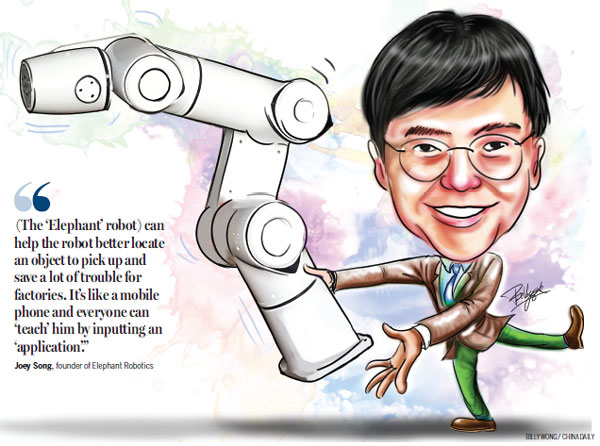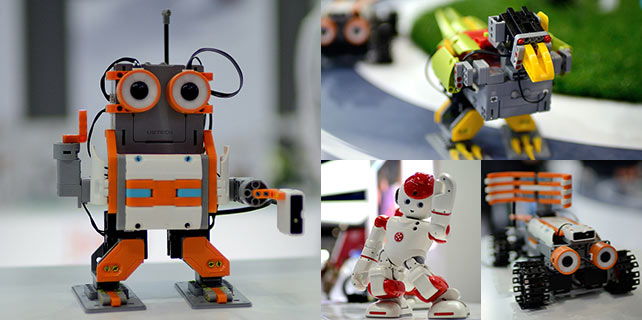'Elephant'joins the robotic revolution

With manual labor fast making way for robots in factories in the Pearl River Delta, entrepreneur Joey Song has developed an industrial robot that can collaborate with people.
Compared with the traditional industrial robot, the "cooperative" robot is smaller in shape, safer to operate and easier to program, explains Song, who founded Elephant Robotics in Shenzhen last year.
His invention, called the "Elephant", consists of a "head" to detect obstacles, a body to move around and the most important part - a robotic arm to pick up and place objects.
Traditional industrial robots are usually large and heavy, but the size of the "Elephant's" arm is almost the same as that a muscular human arm. It can automatically stop when it touches people accidentally.
The user can move the robotic arm without much effort to adjust its work route, Song notes, but a worker needs to push buttons on a controller many times to steer a traditional robotic arm to a targeted position.
The robot's arm is widely used in the manufacturing of automobile, electronic products, and clothing, especially in the making of their small components.
Besides, collaborative robots can also test and package - a working procedure needed in almost all factories - says Song.
According to technology market intelligence company ABI Research, the collaborative robotics sector is expected to grow roughly ten-fold between 2015 and 2020 worldwide, reaching over $1 billion from $95 million in 2015.
Bi Yalei, a professor at the Shenzhen Institute of Advanced Technology under the Chinese Academy of Sciences and secretary-general of the Shenzhen Robotics Association, believes that collaborative robots are becoming popular because many electronic products are now much diversified and constantly changing.
"The trend requires new industrial robots with high flexibility so that factories can quickly transform a whole production line for a new product," he says.
However, sometimes, it may need as long as a month to install traditional robots.
Several emerging robot firms have launched collaborative robots, such as ABB's YuMi, Rethink Robotics' Sawyer and Universal Robots' UR family of robots.
Song believes his little robot can provide more, thanks to the integration with the vision system. A camera is placed at the end of the "elephant's" arm, and the team also writes vision recognition algorithm themselves.
"It can help the robot better locate an object to pick up and save a lot of trouble for factories," he notes.
Currently, factories have to purchase robots and a vision system from two different companies, while a system integrator can join them into one.
Another advantage of the "Elephant" is its price. It costs only half that of existing cooperative robots, which are tagged at between $20,000 and $30,000 apiece.
Song says their secret is to use a special technique so that the structure of new cooperative robots can be combined with that of traditional robotic motors and gears that are already in mass production, so the cost can be sharply reduced.
In addition, Elephant Robotics writes its own operating control system, but Song stresses that their strategy is to produce high-quality, rather than cheap products, and to cater to major manufacturers.
The "Elephant" has earned favor from a foreign client who operates more than 30 factories on the Chinese mainland, and the startup is customizing additional functions for them.
Song began cultivating an interest in innovation while at college in Xi'an, Shaanxi province. The passion drove him to invent a dozen creations and he came in second in a mathematical competition in the US.
The innovation also helped him get enrolled at the University of Melbourne, where he invented his first robot with his teammates.
Last year, Song and business partner Kirin Wu founded the startup. Their creation of snack-stealing and automatic hotpot robots won the support of the world's largest hardware incubator HAX Accelerator.
Since then, they've started to focus on industrial robots. To get familiar with the market, they had spent every weekend in different factories around Shenzhen for about four months.
His dream is to invent a robot that can do all kinds of things for man. "It's like a mobile phone and everyone can 'teach' him by inputting an 'application'."
The team has also set up a platform to put various functions to their robot, such as 3D printing and image recognition.
grace@chinadailyhk.com









